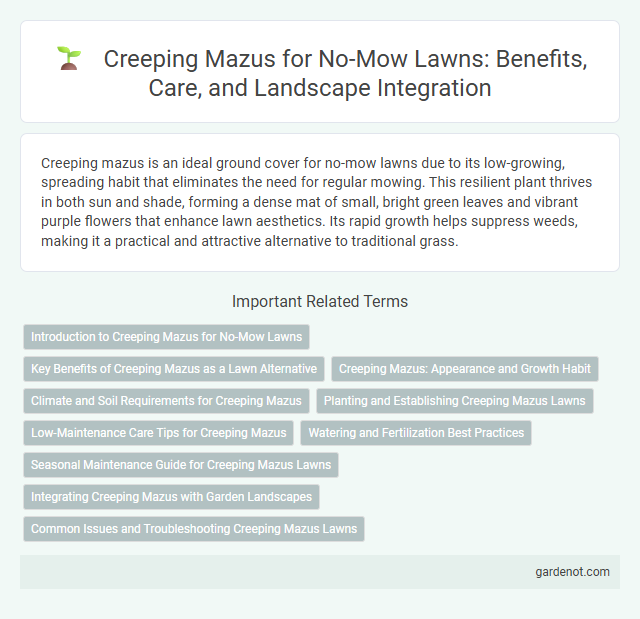Creeping mazus is an ideal ground cover for no-mow lawns due to its low-growing, spreading habit that eliminates the need for regular mowing. This resilient plant thrives in both sun and shade, forming a dense mat of small, bright green leaves and vibrant purple flowers that enhance lawn aesthetics. Its rapid growth helps suppress weeds, making it a practical and attractive alternative to traditional grass.
Introduction to Creeping Mazus for No-Mow Lawns
Creeping Mazus (Mazus reptans) is an ideal ground cover for no-mow lawns due to its low-growing, spreading habit and vibrant purple flowers that bloom from spring to early summer. This perennial plant thrives in well-drained soil and partial to full sun, forming a dense mat that suppresses weeds and reduces the need for mowing. Its tolerance to foot traffic and rapid growth make Creeping Mazus a sustainable, low-maintenance alternative to traditional turfgrass in eco-friendly landscapes.
Key Benefits of Creeping Mazus as a Lawn Alternative
Creeping Mazus offers a low-maintenance, drought-tolerant ground cover that thrives in various soil conditions, making it an ideal no-mow lawn alternative. Its rapid spreading habit forms a dense, lush carpet that effectively suppresses weeds and enhances soil erosion control. The vibrant green foliage and small, tubular flowers provide year-round aesthetic appeal without the need for regular mowing or watering.
Creeping Mazus: Appearance and Growth Habit
Creeping Mazus (Mazus reptans) features small, vibrant purple flowers and dense, glossy green foliage that creates an attractive, carpet-like ground cover. This low-growing perennial spreads rapidly through creeping stems that root at nodes, making it ideal for no-mow lawns and erosion control. Its fast growth habit and tolerance to foot traffic enhance lawn aesthetics with minimal maintenance.
Climate and Soil Requirements for Creeping Mazus
Creeping Mazus thrives in USDA zones 5 to 9, favoring temperate climates with moderate humidity. It requires moist, well-drained soils rich in organic matter, with a pH range between 6.0 and 7.5 for optimal growth. This ground cover tolerates light shade but performs best in full sun to partial shade conditions.
Planting and Establishing Creeping Mazus Lawns
Creeping mazus thrives best when planted in early spring or fall, ensuring soil is consistently moist and well-drained for optimal root establishment. Spreading rapidly as a ground cover, it requires minimal mowing due to its low-growing habit and dense mat formation. Regular watering during establishment encourages vigorous growth, resulting in a lush, no-mow lawn alternative.
Low-Maintenance Care Tips for Creeping Mazus
Creeping Mazus thrives in moist, well-drained soil with partial to full shade, making it an ideal low-maintenance ground cover for no-mow lawns. Regular watering during dry periods and occasional trimming to control spread ensure healthy growth without demanding frequent mowing. Applying a thin layer of mulch helps retain soil moisture and suppress weeds, minimizing upkeep efforts further.
Watering and Fertilization Best Practices
Creeping mazus thrives with consistent moisture but should not be overwatered to prevent root rot; watering deeply once or twice a week is ideal, depending on soil conditions and climate. Fertilize creeping mazus sparingly using a balanced, slow-release fertilizer in early spring to promote healthy growth without encouraging excessive leafiness. Avoid high nitrogen fertilizers which can lead to lush foliage but weaken the plant's mat-forming habit essential for no-mow lawn applications.
Seasonal Maintenance Guide for Creeping Mazus Lawns
Creeping Mazus lawns require minimal mowing due to their low growth habit, making them ideal for no-mow landscapes. Seasonal maintenance involves regular watering during dry periods, light fertilization in early spring to promote vibrant growth, and occasional trimming to manage any overgrowth along edges. Proper care ensures Creeping Mazus remains a dense, weed-resistant ground cover throughout the growing season.
Integrating Creeping Mazus with Garden Landscapes
Creeping Mazus thrives as a low-maintenance ground cover that enhances garden landscapes with its dense, mat-forming growth and vibrant purple flowers. Its ability to suppress weeds and tolerate foot traffic makes it an ideal choice for no-mow lawn alternatives, providing year-round greenery and visual interest. Integrating Creeping Mazus into garden beds or between stepping stones creates a cohesive, natural look while reducing lawn care efforts.
Common Issues and Troubleshooting Creeping Mazus Lawns
Creeping Mazus lawns often face issues such as poor drainage leading to root rot and fungal infections, which stunt growth and cause yellowing leaves. To troubleshoot, improve soil aeration, reduce watering frequency, and apply a fungicide if necessary to control pathogens. Regularly removing debris and monitoring sunlight exposure helps maintain healthy, vibrant Creeping Mazus ground cover.
Creeping mazus Infographic

 gardenot.com
gardenot.com